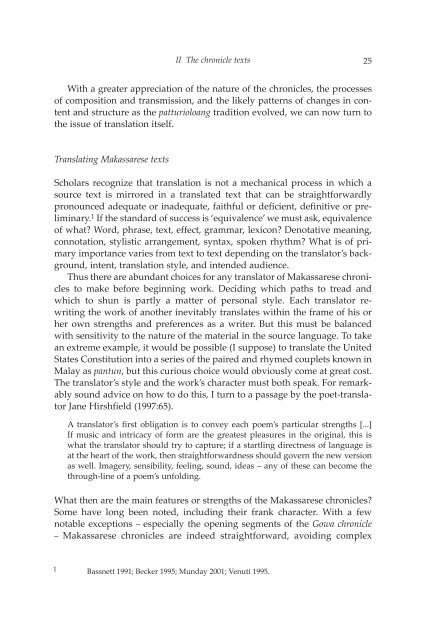A CHAIN OF KINGS - Books and Journals
A CHAIN OF KINGS - Books and Journals
A CHAIN OF KINGS - Books and Journals
Create successful ePaper yourself
Turn your PDF publications into a flip-book with our unique Google optimized e-Paper software.
II The chronicle texts 25<br />
With a greater appreciation of the nature of the chronicles, the processes<br />
of composition <strong>and</strong> transmission, <strong>and</strong> the likely patterns of changes in content<br />
<strong>and</strong> structure as the patturioloang tradition evolved, we can now turn to<br />
the issue of translation itself.<br />
Translating Makassarese texts<br />
Scholars recognize that translation is not a mechanical process in which a<br />
source text is mirrored in a translated text that can be straightforwardly<br />
pronounced adequate or inadequate, faithful or deficient, definitive or preliminary.<br />
1 If the st<strong>and</strong>ard of success is ‘equivalence’ we must ask, equivalence<br />
of what? Word, phrase, text, effect, grammar, lexicon? Denotative meaning,<br />
connotation, stylistic arrangement, syntax, spoken rhythm? What is of primary<br />
importance varies from text to text depending on the translator’s background,<br />
intent, translation style, <strong>and</strong> intended audience.<br />
Thus there are abundant choices for any translator of Makassarese chronicles<br />
to make before beginning work. Deciding which paths to tread <strong>and</strong><br />
which to shun is partly a matter of personal style. Each translator re-<br />
writing the work of another inevitably translates within the frame of his or<br />
her own strengths <strong>and</strong> preferences as a writer. But this must be balanced<br />
with sensitivity to the nature of the material in the source language. To take<br />
an extreme example, it would be possible (I suppose) to translate the United<br />
States Constitution into a series of the paired <strong>and</strong> rhymed couplets known in<br />
Malay as pantun, but this curious choice would obviously come at great cost.<br />
The translator’s style <strong>and</strong> the work’s character must both speak. For remarkably<br />
sound advice on how to do this, I turn to a passage by the poet-translator<br />
Jane Hirshfield (1997:65).<br />
A translator’s first obligation is to convey each poem’s particular strengths [...]<br />
If music <strong>and</strong> intricacy of form are the greatest pleasures in the original, this is<br />
what the translator should try to capture; if a startling directness of language is<br />
at the heart of the work, then straightforwardness should govern the new version<br />
as well. Imagery, sensibility, feeling, sound, ideas ‒ any of these can become the<br />
through-line of a poem’s unfolding.<br />
What then are the main features or strengths of the Makassarese chronicles?<br />
Some have long been noted, including their frank character. With a few<br />
notable exceptions ‒ especially the opening segments of the Gowa chronicle<br />
‒ Makassarese chronicles are indeed straightforward, avoiding complex<br />
1<br />
Bassnett 1991; Becker 1995; Munday 2001; Venuti 1995.









![Am HaSefer [Volk des Buches] - Books and Journals](https://img.yumpu.com/20648352/1/174x260/am-hasefer-volk-des-buches-books-and-journals.jpg?quality=85)







